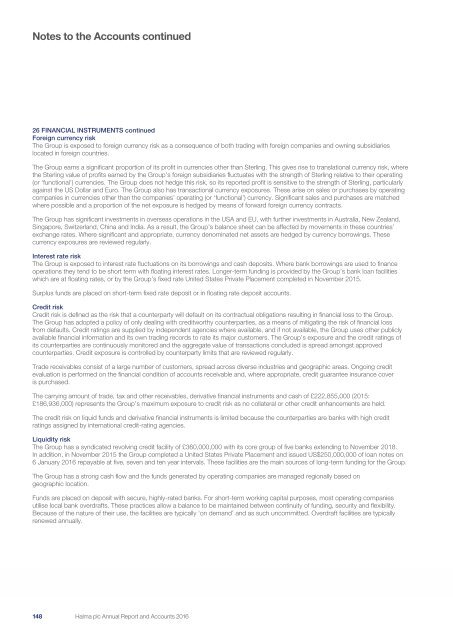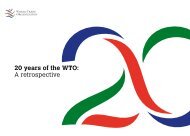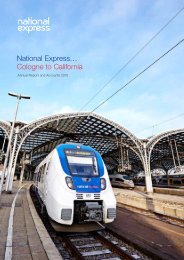Create successful ePaper yourself
Turn your PDF publications into a flip-book with our unique Google optimized e-Paper software.
Notes to the Accounts continued<br />
26 FINANCIAL INSTRUMENTS continued<br />
Foreign currency risk<br />
The Group is exposed to foreign currency risk as a consequence of both trading with foreign companies and owning subsidiaries<br />
located in foreign countries.<br />
The Group earns a significant proportion of its profit in currencies other than Sterling. This gives rise to translational currency risk, where<br />
the Sterling value of profits earned by the Group’s foreign subsidiaries fluctuates with the strength of Sterling relative to their operating<br />
(or ‘functional’) currencies. The Group does not hedge this risk, so its reported profit is sensitive to the strength of Sterling, particularly<br />
against the US Dollar and Euro. The Group also has transactional currency exposures. These arise on sales or purchases by operating<br />
companies in currencies other than the companies’ operating (or ‘functional’) currency. Significant sales and purchases are matched<br />
where possible and a proportion of the net exposure is hedged by means of forward foreign currency contracts.<br />
The Group has significant investments in overseas operations in the USA and EU, with further investments in Australia, New Zealand,<br />
Singapore, Switzerland, China and India. As a result, the Group’s balance sheet can be affected by movements in these countries’<br />
exchange rates. Where significant and appropriate, currency denominated net assets are hedged by currency borrowings. These<br />
currency exposures are reviewed regularly.<br />
Interest rate risk<br />
The Group is exposed to interest rate fluctuations on its borrowings and cash deposits. Where bank borrowings are used to finance<br />
operations they tend to be short term with floating interest rates. Longer-term funding is provided by the Group’s bank loan facilities<br />
which are at floating rates, or by the Group’s fixed rate United States Private Placement completed in November 2015.<br />
Surplus funds are placed on short-term fixed rate deposit or in floating rate deposit accounts.<br />
Credit risk<br />
Credit risk is defined as the risk that a counterparty will default on its contractual obligations resulting in financial loss to the Group.<br />
The Group has adopted a policy of only dealing with creditworthy counterparties, as a means of mitigating the risk of financial loss<br />
from defaults. Credit ratings are supplied by independent agencies where available, and if not available, the Group uses other publicly<br />
available financial information and its own trading records to rate its major customers. The Group’s exposure and the credit ratings of<br />
its counterparties are continuously monitored and the aggregate value of transactions concluded is spread amongst approved<br />
counterparties. Credit exposure is controlled by counterparty limits that are reviewed regularly.<br />
Trade receivables consist of a large number of customers, spread across diverse industries and geographic areas. Ongoing credit<br />
evaluation is performed on the financial condition of accounts receivable and, where appropriate, credit guarantee insurance cover<br />
is purchased.<br />
The carrying amount of trade, tax and other receivables, derivative financial instruments and cash of £222,855,000 (2015:<br />
£186,936,000) represents the Group’s maximum exposure to credit risk as no collateral or other credit enhancements are held.<br />
The credit risk on liquid funds and derivative financial instruments is limited because the counterparties are banks with high credit<br />
ratings assigned by international credit-rating agencies.<br />
Liquidity risk<br />
The Group has a syndicated revolving credit facility of £360,000,000 with its core group of five banks extending to November 2018.<br />
In addition, in November 2015 the Group completed a United States Private Placement and issued US$250,000,000 of loan notes on<br />
6 January <strong>2016</strong> repayable at five, seven and ten year intervals. These facilities are the main sources of long-term funding for the Group.<br />
The Group has a strong cash flow and the funds generated by operating companies are managed regionally based on<br />
geographic location.<br />
Funds are placed on deposit with secure, highly-rated banks. For short-term working capital purposes, most operating companies<br />
utilise local bank overdrafts. These practices allow a balance to be maintained between continuity of funding, security and flexibility.<br />
Because of the nature of their use, the facilities are typically ‘on demand’ and as such uncommitted. Overdraft facilities are typically<br />
renewed annually.<br />
148 146<br />
<strong>Halma</strong> plc Annual Report and Accounts <strong>2016</strong>

















